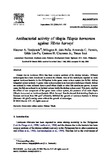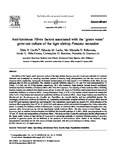Ipakita ang simpleng tala ng item
Efficiency of Chlorella sp. and Tilapia hornorum in controlling the growth of luminous bacteria in a simulated shrimp culture environment
Share
| dc.contributor.author | Tendencia, Eleonor | |
| dc.contributor.author | dela Peña, Milagros R. | |
| dc.contributor.author | Choresca, Casiano H., Jr. | |
| dc.date.accessioned | 2014-05-13T08:42:15Z | |
| dc.date.available | 2014-05-13T08:42:15Z | |
| dc.date.issued | 2005 | |
| dc.identifier.citation | Tendencia, E. A., dela Peña, M. R., & Choresca Jr., C. H. (2005). Efficiency of Chlorella sp. and Tilapia hornorum in controlling the growth of luminous bacteria in a simulated shrimp culture environment. Aquaculture, 249(1-4), 55-62. | en |
| dc.identifier.issn | 0044-8486 | |
| dc.identifier.uri | http://hdl.handle.net/10862/2041 | |
| dc.description.abstract | This study clarifies the effect of green water from Chlorella sp., Tilapia hornorum and the combination of the two organisms on the growth of luminous bacteria in a simulated shrimp culture environment. Results showed that the presence of Chlorella sp. (105 cells/ml) alone was not effective in the control of luminous bacteria in shrimp (biomass=80 g/m3) rearing water. The presence of T. hornorum alone (biomass=500 g/m3) was more efficient in controlling the growth of luminous bacteria than the co-existence of tilapia and Chlorella sp. Nevertheless, the presumptive Vibrio count was lowest in control tanks that had the highest shrimp survival rate, which was attributed to the presence of other micro-algae such as Chaetoceros, Thalassiosira, Navicula, Nitszchia, Melosira, and Fragilaria. | en |
| dc.description.sponsorship | The study was funded by the Government of Japan through the Trust Fund granted to SEAFDEC AQD (GOJ TF 6251-300-60) and SEAFDEC AQD under study code FH 07 C2001T. | en |
| dc.language.iso | en | en |
| dc.publisher | Elsevier | en |
| dc.subject | Chlorella | en |
| dc.subject | Penaeidae | en |
| dc.subject | Vibrio | en |
| dc.subject | Penaeus monodon | en |
| dc.subject | Green water | en |
| dc.subject | tilapia | en |
| dc.title | Efficiency of Chlorella sp. and Tilapia hornorum in controlling the growth of luminous bacteria in a simulated shrimp culture environment | en |
| dc.type | Article | en |
| dc.citation.volume | 249 | |
| dc.citation.issue | 1-4 | |
| dc.citation.spage | 55 | |
| dc.citation.epage | 62 | |
| dc.citation.journalTitle | Aquaculture | en |
| dc.subject.asfa | biological control | en |
| dc.subject.asfa | biotic factors | en |
| dc.subject.asfa | brackishwater fishes | en |
| dc.subject.asfa | cultured organisms | en |
| dc.subject.asfa | growth rate | en |
| dc.subject.asfa | luminous organisms | en |
| dc.subject.asfa | microorganisms | en |
| dc.subject.asfa | pathogenic bacteria | en |
| dc.subject.asfa | phytoplankton | en |
| dc.subject.asfa | shrimp culture | en |
| dc.subject.asfa | water quality control | en |
| dc.subject.asfa | Bacteria | en |
| dc.identifier.doi | 10.1016/j.aquaculture.2005.01.027 | |
| dc.subject.scientificName | Chaetoceros | en |
| dc.subject.scientificName | Penaeus monodon | en |
| dc.subject.scientificName | Fragilaria | en |
| dc.subject.scientificName | Melosira | en |
| dc.subject.scientificName | Navicula | en |
| dc.subject.scientificName | Thalassiosira | en |
| dc.subject.scientificName | Tilapia hornorum | en |
Mga file sa item na ito
| Mga file | Sukat | Format | Tingnan |
|---|
Lumilitaw ang item na ito sa sumusunod na (mga) Koleksyon
-
AQD Journal Articles [1223]
These papers were contributed by AQD staff to various national and international journals



